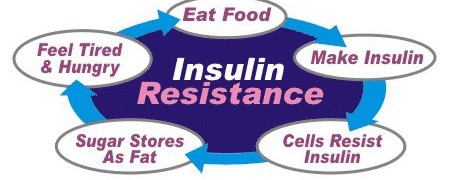
These were a big hit at the Weston A. Price Foundation Temecula Potluck held at Primal Pastures last month.

These were a big hit at the Weston A. Price Foundation Temecula Potluck held at Primal Pastures last month.

This delicious no sugar added ice cream is a wonderful finish for a meal or a guilt free snack on it’s own.
Continue reading “Simple No Sugar Added Vanilla Ice Cream” »

How to Manage/Regulate Blood Sugar
The primary goal of this meal plan is to focus on blood sugar regulation through better food choices, moderate exercise and stress management. Insulin resistance is clearly caused by poor food choices, namely, overconsumption of refined carbohydrates and poor quality fats, and lack of exercise leading to weight gain and other risk factors (see previous post on Insulin Resistance).
Continue reading “Insulin Resistance Part II: How to Manage/Regulate Blood Sugar” »

Insulin resistance is a condition in which the body produces insulin but does not use it properly. Insulin, a hormone made by the pancreas, helps the body use glucose for energy. Glucose is a form of sugar that is the body’s main source of energy. The body’s digestive system breaks food down into glucose, which then travels in the bloodstream to cells throughout the body. Glucose in the blood is called blood glucose, also known as blood sugar. As the blood glucose level rises after a meal, the pancreas releases insulin to help cells take in and use the glucose. When people are insulin resistant, their muscle, fat, and liver cells do not respond properly to insulin. As a result, their bodies need more insulin to help glucose enter cells. The pancreas tries to keep up with this increased demand for insulin by producing more. Eventually, the pancreas fails to keep up with the body’s need for insulin. Excess glucose builds up in the bloodstream, setting the stage for diabetes.
Many people with insulin resistance have high levels of both glucose and insulin circulating in their blood at the same time. Insulin resistance increases the chance of developing type 2 diabetes and heart disease. Many people with insulin resistance and high blood glucose have other conditions that increase the risk of developing type 2 diabetes and damage to the heart and blood vessels, also called cardiovascular disease. These conditions include having excess weight around the waist, high blood pressure, and abnormal levels of cholesterol and triglycerides in the blood. Having several of these problems is called metabolic syndrome or insulin resistance syndrome, formerly called syndrome X.
Pre-diabetes is a condition in which blood glucose levels are higher than normal but not high enough for a diagnosis of diabetes. This condition is sometimes called impaired fasting glucose (IFG) or impaired glucose tolerance (IGT), depending on the test used to diagnose it. The U.S. Department of Health and Human Services estimates that about one in four U.S. adults aged 20 years or older-or 57 million people-had pre-diabetes in 2007. People with pre-diabetes are at increased risk of developing type 2 diabetes, formerly called adult-onsetdiabetes or noninsulin-dependent diabetes. Type 2 diabetes is sometimes defined as the form of diabetes that develops when the body does not respond properly to insulin, as opposed to type 1 diabetes, in which the pancreas makes little or no insulin.
Signs and Symptoms of Insulin Resistance
Insulin resistance and pre-diabetes usually have no symptoms. People may have one or both conditions for several years without noticing anything. People with a severe form of insulin resistance may have dark patches of skin, usually on the back of the neck. Sometimes people have a dark ring around their neck. Other possible sites for dark patches include elbows, knees, knuckles, and armpits. This condition is called acanthosis nigricans.
Risk Factors for developing IR
The American Diabetes Association recommends that testing to detect pre-diabetes and type 2 diabetes be considered in adults without symptoms who are overweight or obese and have one or more additional risk factors for diabetes. In those without these risk factors, testing should begin at age 45.
Risk factors for pre-diabetes and diabetes-in addition to being overweight or obese or being age 45 or older-include the following:
•being physically inactive
•having a parent or sibling with diabetes
•having a family background that is African American, Alaska Native, American Indian, Asian American, Hispanic/Latino, or Pacific Islander
•giving birth to a baby weighing more than 9 pounds or being diagnosed with gestational diabetes-diabetes first found during pregnancy
•having high blood pressure-140/90 or above-or being treated for high blood pressure
•having an HDL, or “good,” cholesterol level below 35 mg/dL or a triglyceride level above 250 mg/dL
•having polycystic ovary syndrome, also called PCOS
•having impaired fasting glucose (IFG) or impaired glucose tolerance (IGT) on previous testing •having other conditions associated with insulin resistance, such as severe obesity or acanthosis
•having a history of cardiovascular disease
If you have any other these conditions, you should consider seeing your physician for further testing.
Resources:
American Diabetic Association (ADA). (2006). Total prevalence of diabetes and pre-diabetes. Retrieved from http://www.diabetes.org/diabetes-statistics/prevalence.jsp
Bauman, E. and Friedlander, J. (2011). Therapeutic Nutrition-Part One. Penngrove, CA Bauman College
Murray, M. (1996). The Encyclopedia of Nutritional Supplements. Roseville, CA Prima
Murray, M., Pizzorno, J., and Pizzorno, l. (2005). The Encyclopedia of Healing Foods. New York: Atria Books
WebMD (2010, copyright). Insulin resistance and diabetes. Retrieved fromhttp://diabetes.webmd.com/guide/insulin-resistance-syndrome

A few posts ago, I shared some before pictures that were taken this past July at 162.2 pounds. This morning I weighed in at 150.4 and nearing my goal! But what is my goal??? Maybe a little background about my weight loss journey will help answer that question. Continue reading “Are My Goal Jeans Really My Size?” »